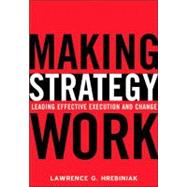
Note: Supplemental materials are not guaranteed with Rental or Used book purchases.
Purchase Benefits
What is included with this book?
| Introduction | |
| Strategy Execution Is the Key | |
| Execution Is a Key to Success | |
| Making Strategy Work Is More Difficult Than the Task of Strategy Making | |
| Sound Execution Is Critical-A Focus on Making Strategy Work Pays Major Dividends | |
| Managers Are Trained to Plan, Not Execute | |
| Let the "Grunts" Handle Execution | |
| Planning and Execution Are Interdependent | |
| Execution Takes Longer Than Formulation | |
| Execution Is a Process, Not an Action or Step | |
| Execution Involves More People Than Strategy Formulation Does | |
| Additional Challenges and Obstacles to Successful Execution | |
| Wharton-Gartner Survey | |
| Wharton Executive Education Survey | |
| Panel Discussions | |
| The Results: Opinions About Successful Strategy Execution | |
| Poor Execution Outcomes | |
| Making Sense of the Data and Going Forward | |
| The Execution Challenge | |
| Having a Model or Guidelines for Execution | |
| Strategy is the Primary Driver | |
| Managing Change | |
| The Power Structure | |
| Coordination and Information Sharing | |
| Clear Responsibility and Accountability | |
| The Right Culture | |
| Leadership | |
| Controls, Feedback, and Adaptation | |
| The Next Step: Developing a Logical Approach to Execution Decisions and Actions | |
| Summary | |
| Endnotes | |
| Overview and Model: Making Strategy Work | |
| Common vs | |
| Unique Execution Solutions | |
| A Need for Action | |
| A Model of Strategy Execution | |
| Corporate Strategy | |
| Corporate Structure | |
| Need for Integration | |
| Executing Business Strategy | |
| "Demands" of Business Strategy | |
| Integrating Strategy and Short-term Operating Objectives | |
| Incentives and Controls | |
| Incentives | |
| Controls | |
| Context of Execution Decisions | |
| The Execution Context | |
| Managing Change | |
| Culture | |
| The Organizational Power Structure | |
| The Leadership Climate | |
| Need for a Disciplined Approach | |
| Summary | |
| Endnotes | |
| The Path to Successful Execution: Good Strategy Comes First | |
| Is the Impact of Strategy Overrated? | |
| The Need for Sound Planning and a Clear, Focused Strategy | |
| Corporate-Level Planning | |
| AT&T: Bad Corporate Strategy? | |
| Business Strategy | |
| The Importance of Integrating Corporate and Business Strategies | |
| The Role of the Business Is Unclear | |
| Inappropriate Performance Metrics | |
| Battles Over Resource Allocations | |
| Assessments of Business Performance Create Additional Problems | |
| The Strategy Review | |
| The Need to Define and Communicate the Operational Components of Strategy | |
| Integrating Strategic and Short-Term Objectives | |
| Need for Measurable Objectives | |
| Understanding the "Demands" of Strategy and Successful Execution | |
| Low-Cost Producer | |
| Differentiation Strategies | |
| Developing the Right Capabilities | |
| The Demands of Global Strategy | |
| A Final Point | |
| Summary | |
| Endnotes | |
| Organizational Structure and Execution | |
| The Challenge of Structural Choice | |
| General Motors | |
| Johnson & Johnson | |
| Citibank and ABB | |
| The Critical Structural Issues | |
| Structural Issue #1: Measuring Costs and Benefits of Structure | |
| Structural Issue #2: Centralization vs | |
| Decentralization | |
| Structural Issue #3: The Strategy-Structure-Performance Relationship | |
| Summary | |
| Endnotes | |
| Managing Integration: Effective Coordination and Information Sharing | |
| The Importance of Integration | |
| Boeing | |
| Royal Dutch/Shell Group | |
| Dell Computers | |
| Interdependence and Coordination Methods | |
| Types of Interdependence | |
| Coordination Processes and Methods | |
| The GE "Work Out" | |
| Facilitatin | |
| Table of Contents provided by Publisher. All Rights Reserved. |
The New copy of this book will include any supplemental materials advertised. Please check the title of the book to determine if it should include any access cards, study guides, lab manuals, CDs, etc.
The Used, Rental and eBook copies of this book are not guaranteed to include any supplemental materials. Typically, only the book itself is included. This is true even if the title states it includes any access cards, study guides, lab manuals, CDs, etc.